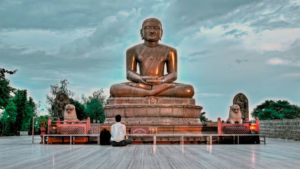Jains celebrate the founder of their small but ancient faith

Today (April 14), Jains are celebrating the birth anniversary of Vardhaman Mahavir, founder of what is today the smallest of India’s six major religious groups — after Hinduism, Islam, Christianity, Sikhism and Buddhism — but one of the oldest.
Mahavir is honored as the Jains’ 24th and last tirthankara, a line of spiritual teachers whose origins are unknown to history. Tirthankara is also expressed in Sanskrit as a “jina,” meaning “one who has conquered” (specifically over material desires) and so the followers of Mahavir came to be known as the Jains.
A contemporary of the Buddha, Mahavir also preached the principle of nonviolence, or ahimsa, but his concept emphasized that no living creature should be harmed. Jains don’t eat many root vegetables, as they are the food for plants.
Known in India as Mahavir Janma Kalyanak (literally: “the auspicious birth day of Mahavir”), the day is celebrated with a national holiday. Across the country, Jain communities carry idols of Mahavir in procession to commemorate his life and teachings. In the U.S., a community of as many as 150,000 Jains, belonging to the traditions Svetambara and Digambara sects, mostly celebrates the day on the nearest weekend day with lectures, cultural events and ceremonies in Jain temples.
According to the ninth-century Jain poet Asaga, whose “Vadhaman Charitra” provides the most detailed account of Mahavir’s life, the 24th tirthankara was born in a royal family in Kundagrama, in eastern India, in 599 B.C. He was named Vardhaman, a Sanskrit word meaning “increase,” as his family prospered after his birth.
Mahavir’s birth was presaged by 14 dreams that came to Trishala, his mother, which were interpreted as a mark of the greatness of the child to be born. In one vision, a lake full of lotuses indicated that he would give up all worldly attachments and a celestial plane that meant that all gods would pay homage to his spiritual teachings.
Jain texts describe his body as marked with signs that indicated he would be a “cakravartin,” a term that describes a conqueror of the world.
In Jain belief, soon after Mahavir’s birth, the Hindu god Indra carried him to the celestial Mount Meru to be consecrated. Hindu gods such as Indra are mentioned in Jain texts as spiritually evolved souls on their path to liberation.
Mahavir married Yashoda and they had a daughter. But at the age of 30, he left his worldly possessions and did extreme penance while wandering in the region of the Ganges basin in northern India for 12 1/2 years.
A second-century Jain text, the Kalpasutra, describes the violence the young monk experienced from fellow humans, animals and insects. Mahavir retained his composure and calm while fasting for days and subjecting his body to extreme rigors as a way to break the bondage of the physical senses. The epithet “Mahavir” (the heroic one) reflects this endurance to his years of submission to a harsh way of life.
He is said to have attained enlightenment at the age of 72 after fasting for 2 1/2 days. Mahavir converted 11 people from the Brahmin caste, who became the leaders, the ganadharas, of the ascetic order.
Mahavir died in Pavapuri, in today’s eastern state of Bihar, in 510 B.C., though various other dates of his death have been proposed and debated since the 19th century. Jains believe that his bones were taken to heaven and his ashes were distributed.
As a liberated soul, Mahavir is said to have achieved omniscience before his death. In Jain beliefs, before a tirthankara passes on, the gods set up a circular arena, known as samavasarana, for the final sermon, a scene often depicted in paintings in Jain temples. In the samavasarana, the tirthankara no longer speaks through his lips; the sound comes through his body. The tirthankara faces east, but three manifestations, facing each of the other compass directions, are seen by those listening to his sermon. Jain temples are regarded as replicas of the samavasarana.
The literal teachings of Mahavir are not known. But as scholar Paul Dundas writes in his book, “The Jains,” the absence of his words does not matter to the Jains, as his teachings are considered no different from those of the tirthankaras who came before him. As Dundas writes, “his biography, rather than being discrete, has to be treated as part of the larger totality of the Universal History, and as meshing, through the continuing dynamic of rebirth, with the lives of other participants within it.”
Jain teachings emphasize how to attain freedom from the cycle of birth and life — the state known as nirvana. In Jain belief, tirthankaras appear in different cosmic periods to provide spiritual guidance on the main Jain teachings, or the Three Jewels: right faith, right action and right knowledge.
At the heart of these teachings are nonviolence, which emphasizes not causing harm to any living beings, be they human beings, animals, insects or plants; truthfulness and not stealing; and, lastly, nonattachment to people, places and material things, or “aparigraha.”
There is no external deity guiding the universe in Jain belief, just the weight of karma that carries souls through multiple births. After liberation, tirthankaras are believed to exist in the uppermost echelons of the universe, as liberated souls.
Every Jain temple has similar-looking idols of serene, calm tirthankaras in meditation pose, with no garments on them. What distinguishes one from another are the symbols associated with each tirthankara. For Mahavir, it is a lion.
Courtesy: RNS



